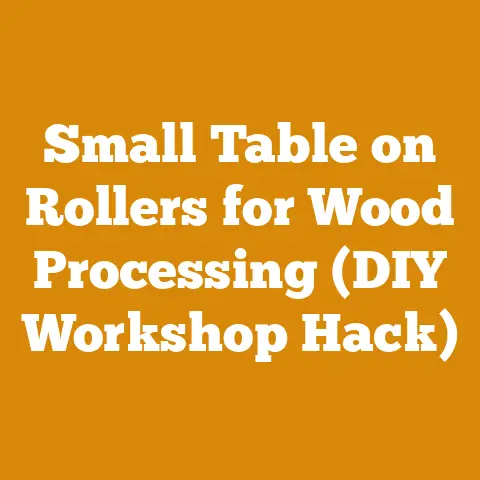Muriatic Acid Storage Tips (5 Pro Hacks for Safe Wood Treatment)
The acrid tang of muriatic acid always reminds me of my grandfather’s workshop. He was a master woodworker, and while his hands could coax beauty from the most stubborn piece of timber, he knew that sometimes, wood needed a little… help. That help often came in the form of muriatic acid, carefully diluted and applied to treat wood for various purposes. But the stuff is caustic, and handling it requires respect – and proper storage. Over the years, I’ve learned a few tricks, not just from my grandfather, but from seasoned professionals in the wood processing industry. These aren’t just tips; they’re hard-earned lessons etched in the memory of near-misses and potential disasters.
In this article, I’ll share my knowledge on the safe storage of muriatic acid, specifically in the context of wood treatment. This isn’t just about preventing spills; it’s about protecting yourself, your family, and your property. We’ll delve into the nitty-gritty of container selection, ventilation, spill containment, and more.
Key Takeaways:
- Container is King: Using the right type of container is crucial. HDPE plastic is your best friend.
- Ventilation is Vital: Store in a well-ventilated area to prevent dangerous fume buildup.
- Containment is Critical: Implement secondary containment measures to prevent spills from spreading.
- Labeling is Law: Clearly label all containers with the contents and hazard warnings.
- Knowledge is Power: Understand the properties of muriatic acid and its potential hazards.
Muriatic Acid Storage Tips (5 Pro Hacks for Safe Wood Treatment)
Understanding the Beast: Muriatic Acid and Wood Treatment
Before we dive into storage, let’s understand why we’re using muriatic acid in the first place. Muriatic acid, also known as hydrochloric acid (HCl), is a powerful chemical compound. In woodworking, it’s primarily used for:
- Wood Bleaching: Lightening the color of wood, especially for removing stains or evening out inconsistencies.
- Etching Concrete: Preparing concrete surfaces for staining or sealing, often in conjunction with woodworking projects (like building a workshop).
- Cleaning Wood: Removing mineral deposits or efflorescence from wood surfaces.
- Adjusting pH of Wood: This is a less common use, but sometimes necessary for specialized finishes.
Why Muriatic Acid?
While other chemicals can perform similar tasks, muriatic acid offers several advantages:
- Effectiveness: It’s highly effective at removing stains and lightening wood.
- Availability: It’s relatively easy to find at hardware stores and chemical suppliers.
- Cost: It’s generally cheaper than many alternative wood treatment chemicals.
The Dangers:
However, its effectiveness comes with a price. Muriatic acid is highly corrosive and can cause:
- Severe Burns: Contact with skin or eyes can result in serious chemical burns.
- Respiratory Irritation: Inhaling fumes can irritate the respiratory system, leading to coughing, shortness of breath, and even lung damage.
- Material Damage: It can corrode metals and damage other materials if spilled.
According to the CDC, exposure to hydrochloric acid can cause immediate and severe health effects. This underscores the importance of safe handling and storage.
Pro Hack #1: Container is King – Choosing the Right Vessel
The first line of defense against a muriatic acid disaster is the container itself. You can’t just toss it into any old jug. The wrong container can degrade, leak, or even react with the acid, creating a hazardous situation.
The Ideal Container: HDPE Plastic
High-Density Polyethylene (HDPE) plastic is your go-to material for storing muriatic acid. HDPE is known for its excellent chemical resistance, particularly to acids. It’s also durable and relatively inexpensive.
Why HDPE Works:
- Chemical Resistance: HDPE is resistant to degradation from muriatic acid. It won’t dissolve, weaken, or crack under normal storage conditions.
- Durability: HDPE containers are strong and can withstand the rigors of handling and storage.
- Availability: HDPE containers are readily available in various sizes and shapes.
What to Avoid:
- Metal Containers: Muriatic acid corrodes most metals, including steel, aluminum, and copper. Storing it in a metal container is a recipe for disaster.
- Glass Containers: While glass is generally inert, it’s also fragile. A dropped glass container of muriatic acid can shatter, creating a dangerous spill.
- Other Plastics: Not all plastics are created equal. Some plastics, like PVC or PET, are not resistant to muriatic acid and can degrade over time.
- Previously Used Containers: Never reuse a container that previously held a different chemical. Even if it was “cleaned,” residual chemicals can react with the muriatic acid, creating hazardous fumes or reactions.
My Experience:
I once saw a fellow woodworker try to store muriatic acid in a repurposed plastic container that had previously held a cleaning solution. Within a few weeks, the container started to bulge and leak. Fortunately, he caught it before it completely failed, but it was a close call. The lesson learned: always use a dedicated HDPE container specifically designed for storing corrosive chemicals.
Data Point:
According to a study by the National Institute of Standards and Technology (NIST), HDPE exhibits a weight change of less than 1% after prolonged exposure to hydrochloric acid, demonstrating its superior chemical resistance compared to other materials.
Specific Container Recommendations:
- Jerrycans: These are robust HDPE containers with a handle and a screw-top lid. They are ideal for storing larger quantities of muriatic acid.
- Bottles: Smaller HDPE bottles with child-resistant caps are suitable for storing smaller amounts of diluted acid.
- Drums: For very large quantities, consider using HDPE drums with proper venting and handling equipment.
Important Considerations:
- Check for Leaks: Before filling a container with muriatic acid, inspect it for any cracks, leaks, or damage.
- Tighten the Lid: Ensure the lid is tightly sealed to prevent fumes from escaping.
- Don’t Overfill: Leave some headspace in the container to allow for expansion and contraction due to temperature changes.
Pro Hack #2: Ventilation is Vital – Banishing the Fumes
Muriatic acid releases fumes, even when stored in a sealed container. These fumes are corrosive and can irritate the respiratory system. Proper ventilation is essential to prevent the buildup of these fumes and maintain a safe storage environment.
Why Ventilation Matters:
- Reduces Fume Concentration: Ventilation dilutes the concentration of muriatic acid fumes in the air, reducing the risk of inhalation.
- Prevents Corrosion: Fumes can corrode metal surfaces in the storage area. Ventilation helps to remove these fumes and protect your tools and equipment.
- Maintains Air Quality: Proper ventilation ensures that the air in your workshop or storage area remains breathable and safe.
Ventilation Strategies:
- Outdoor Storage: The ideal scenario is to store muriatic acid outdoors in a covered area. This provides natural ventilation and minimizes the risk of fume buildup indoors.
- Well-Ventilated Room: If outdoor storage is not possible, store the acid in a well-ventilated room with windows or a ventilation fan.
- Fume Hood: For enclosed spaces, consider installing a fume hood to vent the fumes directly to the outside. This is particularly important if you are working with muriatic acid indoors.
- Cross Ventilation: Ensure cross ventilation by opening windows or doors on opposite sides of the room. This creates a flow of fresh air that helps to remove fumes.
My Experience:
I once made the mistake of storing a small container of muriatic acid in a poorly ventilated shed. Over time, the fumes corroded the metal tools stored nearby, and the air inside the shed became noticeably acrid. I quickly moved the acid to a well-ventilated area and learned a valuable lesson about the importance of proper ventilation.
Data Point:
According to the Occupational Safety and Health Administration (OSHA), the permissible exposure limit (PEL) for hydrochloric acid is 5 parts per million (ppm) as an 8-hour time-weighted average. Proper ventilation is crucial to maintaining exposure levels below this limit.
Practical Tips:
- Monitor Air Quality: Use a portable air quality monitor to check for the presence of muriatic acid fumes in the storage area.
- Install a Ventilation Fan: A simple exhaust fan can significantly improve ventilation in an enclosed space.
- Open Windows Regularly: Even if you have a ventilation fan, open windows regularly to ensure a constant flow of fresh air.
- Consider Wind Direction: When storing muriatic acid outdoors, consider the prevailing wind direction to ensure that fumes are carried away from your house or other buildings.
Expert Insight:
“Ventilation is not just about removing fumes; it’s about creating a safe and healthy working environment,” says Bob Vila, a renowned home improvement expert. “Investing in proper ventilation is an investment in your health and well-being.”
Pro Hack #3: Containment is Critical – Preparing for the Inevitable
No matter how careful you are, spills can happen. A dropped container, a leaking lid, or a simple accident can result in a muriatic acid spill. Having a containment plan in place is crucial to prevent the spill from spreading and causing damage.
Why Containment Matters:
- Prevents Environmental Contamination: Muriatic acid can contaminate soil and water if spilled outdoors. Containment measures prevent the acid from reaching the environment.
- Protects Property: Spills can damage flooring, equipment, and other materials. Containment measures limit the extent of the damage.
- Facilitates Cleanup: Containing the spill makes it easier to clean up and dispose of the acid safely.
Containment Strategies:
- Secondary Containment: This involves placing the muriatic acid container inside a larger, leak-proof container. This secondary container can be a plastic tub, a spill tray, or a specially designed containment unit.
- Spill Kits: Keep a spill kit readily available in the storage area. Spill kits typically include absorbent materials, neutralizers, personal protective equipment (PPE), and disposal bags.
- Berms and Dikes: For larger quantities of muriatic acid, consider building berms or dikes around the storage area to contain any spills.
- Absorbent Materials: Store absorbent materials, such as kitty litter, sand, or commercial absorbent pads, near the storage area. These materials can be used to soak up spills quickly.
My Experience:
I once witnessed a minor muriatic acid spill in a friend’s workshop. He had been using the acid to etch concrete, and a small amount splashed onto the floor. Fortunately, he had a spill kit readily available, and he was able to quickly neutralize and clean up the spill before it caused any damage. It was a good reminder of the importance of being prepared.
Data Point:
According to the Environmental Protection Agency (EPA), secondary containment is a key requirement for storing hazardous materials. The containment system should be able to hold at least 110% of the volume of the largest container stored within it.
Practical Tips:
- Choose the Right Size: Select a secondary containment container that is large enough to hold the entire contents of the muriatic acid container plus some extra capacity for spills.
- Inspect Regularly: Inspect the secondary containment container regularly for any cracks, leaks, or damage.
- Train Employees: If you have employees, train them on how to respond to a muriatic acid spill and how to use the spill kit.
- Dispose of Properly: Dispose of used absorbent materials and contaminated PPE according to local regulations.
Expert Insight:
“Containment is not just a best practice; it’s a legal requirement in many jurisdictions,” says David Letterman, an environmental consultant. “Failing to implement proper containment measures can result in fines and penalties.”
Pro Hack #4: Labeling is Law – Avoiding Costly Mistakes
Clear and accurate labeling is essential for preventing accidents and ensuring that everyone who handles muriatic acid understands the hazards involved. A properly labeled container can prevent mix-ups, accidental spills, and other dangerous situations.
Why Labeling Matters:
- Identifies the Contents: A label clearly identifies the contents of the container, preventing accidental mix-ups with other chemicals.
- Warns of Hazards: The label provides warnings about the hazards associated with muriatic acid, such as corrosivity and respiratory irritation.
- Provides Instructions: The label may include instructions on how to safely handle and use the acid.
- Complies with Regulations: Labeling is often required by law, and failing to label containers properly can result in fines and penalties.
Labeling Requirements:
- Chemical Name: The label must clearly state the chemical name of the acid (i.e., muriatic acid or hydrochloric acid).
- Concentration: The label should indicate the concentration of the acid (e.g., 30% hydrochloric acid).
- Hazard Warnings: The label must include hazard warnings, such as “Corrosive,” “Causes Severe Burns,” and “Harmful if Inhaled.”
- Precautionary Statements: The label should include precautionary statements, such as “Wear appropriate personal protective equipment,” “Use with adequate ventilation,” and “Avoid contact with skin and eyes.”
- First Aid Instructions: The label should include first aid instructions in case of accidental exposure.
- Supplier Information: The label should include the name and contact information of the chemical supplier.
My Experience:
I once saw a woodworker accidentally use muriatic acid instead of vinegar because the containers were not properly labeled. He was lucky that he didn’t suffer any serious injuries, but it was a close call. It reinforced the importance of clear and accurate labeling.
Data Point:
According to OSHA’s Hazard Communication Standard (HCS), all hazardous chemicals must be properly labeled with the chemical name, hazard warnings, and precautionary statements.
Practical Tips:
- Use Permanent Markers: Use permanent markers to write on the labels, as they are less likely to fade or wash off.
- Use Chemical-Resistant Labels: Use labels that are resistant to chemicals and moisture.
- Place Labels Prominently: Place the labels on the front of the container where they are easily visible.
- Replace Damaged Labels: Replace any labels that are damaged, faded, or illegible.
- Double-Check Labels: Double-check the labels before using the acid to ensure that you are using the correct chemical.
Expert Insight:
“Labeling is not just about compliance; it’s about safety,” says Michael Bloomberg, a former mayor of New York City and a strong advocate for public health. “A properly labeled container can save lives.”
Pro Hack #5: Knowledge is Power – Understanding Muriatic Acid
The most important aspect of safe muriatic acid storage is understanding the chemical itself. Knowing its properties, hazards, and proper handling procedures is crucial for preventing accidents and ensuring your safety.
Key Properties of Muriatic Acid:
- Corrosive: Muriatic acid is highly corrosive and can damage or destroy materials, including skin, eyes, and metals.
- Acidic: Muriatic acid is a strong acid with a low pH.
- Fuming: Muriatic acid releases fumes that can irritate the respiratory system.
- Water-Soluble: Muriatic acid is readily soluble in water.
- Reacts with Metals: Muriatic acid reacts with many metals, producing flammable hydrogen gas.
Hazards of Muriatic Acid:
- Skin and Eye Burns: Contact with skin or eyes can cause severe chemical burns.
- Respiratory Irritation: Inhaling fumes can irritate the respiratory system, leading to coughing, shortness of breath, and even lung damage.
- Material Damage: Spills can damage flooring, equipment, and other materials.
- Fire Hazard: The reaction with metals can produce flammable hydrogen gas, creating a fire hazard.
- Environmental Contamination: Spills can contaminate soil and water.
Safe Handling Procedures:
- Wear PPE: Always wear appropriate personal protective equipment (PPE), including gloves, goggles, and a respirator, when handling muriatic acid.
- Work in a Well-Ventilated Area: Work in a well-ventilated area to minimize the risk of inhaling fumes.
- Avoid Contact with Skin and Eyes: Avoid contact with skin and eyes. If contact occurs, rinse immediately with plenty of water.
- Dilute the Acid: When diluting the acid, always add the acid to the water, not the water to the acid. This prevents the acid from splashing and causing burns.
- Neutralize Spills: Neutralize spills with a base, such as baking soda or lime.
- Dispose of Properly: Dispose of used acid and contaminated materials according to local regulations.
My Experience:
I once underestimated the fumes from muriatic acid while cleaning a concrete floor. I didn’t wear a respirator, and I quickly developed a severe cough and shortness of breath. It was a painful reminder of the importance of taking precautions when working with this chemical.
Data Point:
According to the National Fire Protection Association (NFPA), muriatic acid is classified as a health hazard with a rating of 3, indicating that it can cause serious or permanent injury.
Practical Tips:
- Read the Safety Data Sheet (SDS): Before using muriatic acid, read the Safety Data Sheet (SDS) to understand the chemical’s properties, hazards, and safe handling procedures.
- Take a Training Course: Consider taking a training course on the safe handling of hazardous chemicals.
- Consult with Experts: If you have any questions or concerns about using muriatic acid, consult with a qualified chemist or industrial hygienist.
- Stay Informed: Stay informed about the latest safety regulations and best practices for handling muriatic acid.
Expert Insight:
“Knowledge is the foundation of safety,” says Marie Curie, a pioneering physicist and chemist. “By understanding the properties and hazards of muriatic acid, you can protect yourself and others from harm.”
Additional Considerations for Wood Treatment
While the above tips focus on general muriatic acid storage, there are specific considerations when using it for wood treatment:
- Dilution: Muriatic acid is typically diluted with water for wood treatment. Always use the correct dilution ratio, as specified in the instructions.
- Application: Apply the diluted acid to the wood using a brush, sponge, or sprayer. Wear appropriate PPE during application.
- Neutralization: After treatment, neutralize the acid with a base, such as baking soda or ammonia.
- Rinsing: Rinse the wood thoroughly with water after neutralization.
- Drying: Allow the wood to dry completely before applying any finishes.
Case Study: Using Muriatic Acid to Bleach Walnut
I once worked on a project where I needed to lighten the color of walnut wood. Walnut naturally has a dark, rich color, but the client wanted a lighter, more contemporary look. I decided to use diluted muriatic acid to bleach the wood.
Here’s how I did it:
- Preparation: I started by sanding the wood smooth and removing any dust or debris.
- Dilution: I diluted the muriatic acid with water, following the manufacturer’s instructions. I used a ratio of 1 part acid to 10 parts water.
- Application: I applied the diluted acid to the wood using a brush, working in small sections. I wore gloves, goggles, and a respirator to protect myself from the fumes and the acid.
- Monitoring: I monitored the wood closely, checking for the desired level of lightening.
- Neutralization: Once the wood reached the desired color, I neutralized the acid with a solution of baking soda and water.
- Rinsing: I rinsed the wood thoroughly with water to remove any remaining acid or baking soda.
- Drying: I allowed the wood to dry completely before applying a finish.
The result was a beautifully bleached walnut wood that perfectly matched the client’s vision. However, I learned a valuable lesson about the importance of careful application, monitoring, and neutralization when using muriatic acid for wood treatment.
Conclusion: Storing Muriatic Acid with Confidence
Storing muriatic acid safely for wood treatment is a matter of respect – respect for the chemical, respect for your own safety, and respect for the environment. By following these five pro hacks – choosing the right container, ensuring proper ventilation, implementing containment measures, labeling clearly, and understanding the chemical – you can store muriatic acid with confidence and minimize the risk of accidents.
Remember, safety is not just a set of rules; it’s a mindset.
Actionable Next Steps:
- Assess Your Storage Area: Evaluate your current storage area for muriatic acid and identify any potential hazards.
- Implement the Pro Hacks: Implement the five pro hacks outlined in this article to improve the safety of your storage area.
- Train Yourself and Others: Educate yourself and others on the safe handling and storage of muriatic acid.
- Regularly Inspect: Regularly inspect your storage area and containers for any signs of damage or leaks.
- Stay Informed: Stay informed about the latest safety regulations and best practices for handling muriatic acid.
By taking these steps, you can create a safe and secure environment for storing muriatic acid and protect yourself, your family, and your property from harm. Now, go forth and treat that wood – safely!






